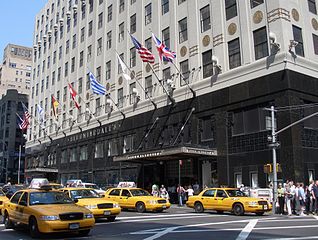- 1872 – Bloomingdale brothers opened their first store at 938 Third Avenue, New York City.
- 1955 – The Mickey Mouse Club debuts on ABC.
- 1964 – First Buffalo Wings are made at the Anchor Bar in Buffalo, New York.
Bloomingdale’s started in 1861 when brothers Joseph and Lyman G. Bloomingdale started selling hoop-skirts in their Ladies Notions’ Shop on Manhattan’s Lower East Side. The pair were sons of Benjamin Bloomingdale, a Bavarian-born salesman who had lived in North Carolina and Kansas, and settled in New York City. In 1872, the Bloomingdale brothers opened their first store at 938 Third Avenue, New York City.
As the popularity of the hoop-skirt was declining, the brothers closed their East Side Bazaar in 1872 in a small row house on Third Avenue and 56th Street, selling a variety of garments such as ladies’ skirts, corsets, “gent’s furnishings”, and European fashions. At the time the East Side was a working-class neighborhood with shantytowns, garbage dumps, and stockyards. Most of their customers and competitors were in the Upper West Side, and at that time most ‘respectable stores’ only specialized in one trade.
Within a few years after opening the store, the Metropolitan Museum of Art opened, the new St. Patrick’s Cathedral was dedicated near the store after moving from its downtown location, Central Park was completed, and the New York subway system began construction. These additions brought wealthy customers to the East Side, and built brownstones that surrounded the new park.
The store moved in 1886 to its current location on 59th Street and Lexington Avenue. It was designed with large plate glass display windows and large merchandising areas. Instead of the common practice of cluttering the display windows with an assortment of the goods they sold, each window featured a couple of products as props on a theatrical mise-en-scene. Many of these products were European imports.
By the turn of the 19th to 20th century, Bloomingdale’s growth greatly increased, facilitated by its convenient location at a hub of New York City’s horse-drawn trolley system. Offerings at the time ranged from ladies’ stockings at 10¢ a pair to $10 men’s wool suits and $149 upright pianos. In 1902, the advertising slogan “All Cars Transfer to Bloomingdale’s” capitalized on the store’s location, and the company commissioned artist Richard F. Outcault to create a series of paintings around this theme. The slogan appeared on billboards and on 5,000 free beach umbrellas which were offered to street vendors and delivery cart drivers.
